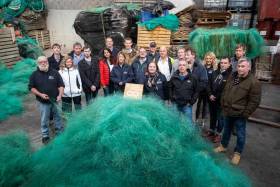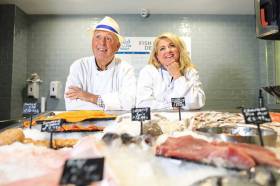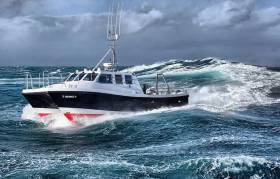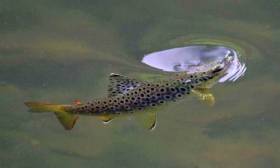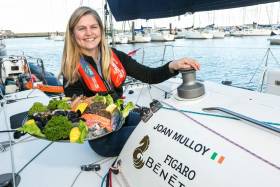Displaying items by tag: BIM
BIM Focus on Smart Net Management at Castletownbere Workshop
Bord Iascaigh Mhara (BIM), Ireland’s seafood development agency, and the Irish South and West Fishermen’s Producers Organisation (ISWFPO) co-hosted a net management workshop in Castletownbere, West Cork this month. The aim of the day-long event, attended by a cross -section of the Irish seafood sector and auxiliary industries, was to track the ‘journey’ of fishing gear from its initial entry into the market to its end of life or ‘retirement’. The workshop also looked at ways to better analyse and understand the source of marine litter brought ashore by the Irish catching fleet today.
New plastics and circular economy polices underpin emerging trends in sustainability. They require member states to minimise the impact of plastics on the environment and to increase the opportunities for used plastics to be recycled and retained instead of ending up on a landfill.
As of October 2019, a total of 224 fishing vessels are registered to Fishing For Litter (FFL). The national programme, where fishing vessels voluntarily collect and take ashore all marine litter they collect during normal fishing activities at sea, forms part of the wider Clean Oceans Initiative. The application of circular economy principles is key to the new national initiative to reduce marine waste so that fishing vessels can develop new ways to record, log and make an inventory of gear and marine waste. To date, 49 vessels are registered to Fishing for Litter in the port of Castletownbere. This represents one fifth of the national fleet.
“The local determination to demonstrate their fishing gear management is outstanding. Other key stakeholders such as the harbour management, net makers are also behind the objective and are keen to help communicate and validate the responsible approach taken by the large majority in Castletownbere”, said Patrick Murphy, CEO, ISWFPO.
The EU Commission is currently developing new ways to monitor and report fishing gear, from being placed on the market to its retirement. The Commission is also exploring ways to better analyse marine litter. The final report will be available in July 2020.
BIM’s establishment of the Fishing for Litter programme in 2015, supported by the European Maritime and Fisheries Fund, has given Ireland a head start. The state agency for the development of the seafood sector is also working on ways to improve the characterisation of waste and marine litter. Progress in this area will ultimately lead to stronger insights about marine waste. BIM has also been handling end of life gear aspects since 2006. However, the new EU directives and polices on plastics will give a new impetus to addressing end of life gear.
“Demonstrating the responsible management of our gear at its end of life is a priority. A full trawl gear could have up to a 10-year life span and is an expensive key piece of equipment. We are keen to work with BIM to identify how best to monitor and record our gear efficiently and to demonstrate this objectively”, explained ISWFPO chairman, Damien Turner.
In September 2015, the General Assembly of the United Nations adopted the 2030 Agenda for Sustainable Development. It comprises 17 Sustainable Development Goals (SDGs). BIM was recently appointed an SDG champion for four of the goals, two of which are particularly relevant where plastics and marine waste are concerned; SDG 14( Life Below Water; a target of which is to help prevent and reduce marine pollution) and SDG12( application of environmentally sound management of all waste through their life cycle).
“The aim of the Champions programme is to raise awareness of the SDGs and to show through the example of the Champions that everyone in society can make a contribution to achieving the 17 Goals. The catching sector is a key contributor to ensuring that we can improve the outcomes for Life Below Water and maximise the lifecycle and recoverable costs of plastics used by the catching sector, the Clean Oceans Initiative will be instrumental in delivering on these SDGs ”, explained Catherine Barrett, BIM.
Representatives from two EU funded projects, ‘Blue Circular Economy’ and ‘Circular Seas’, tasked with creating opportunities for end of life fishing gear, also attended the workshop in Castletownbere.
Launch of Ireland’s first Certified Fishmonger Qualification
Ireland’s first accredited fishmonger qualification has been launched today in the fishing port of Howth, Co Dublin. Bord Iascaigh Mhara (BIM), Ireland’s seafood development agency, has developed the Certificate in Fishmonger Skills accredited by nationally and internationally recognised Quality and Qualifications Ireland (QQI).
Ian Mannix, BIM described how the aim of the training is to retain and attract talent into the industry. He said:
“ Today’s consumer has come to expect their fishmonger to have a broad knowledge of seafood. They want them to be able to advise them when they are at the counter. This new programme will provide solid, fully certified training to anyone working in seafood retailing; practical skills they can then apply in the industry Moreover, improved skills in the workplace will ultimately lead to better sales and better retention of staff.”
The new training combines practical and classroom learning and includes modules on seafood labelling, nutrition and food safety. The programme also includes hands-on demonstrations in fish fileting and culinary skills and is aimed at existing staff in seafood retailing or those interested in pursuing a career in the industry.
Master fishmonger, Hal Dawson is one of the trainers on the new programme. He has worked in the seafood industry since 1972. He said:
“ The new course will provide professionalism within the industry. Having this qualification on your cv, will give fishmongers a real advantage.”
The value of seafood retail sales in 2018 was €297 million according to the BIM Business of Seafood report. Sales of loose fish experienced the sharpest increase (+8%) in comparison to pre-packed (+1%). Salmon remains the number one fish species bought by consumers in Ireland. However, there has been a marked increase in demand for lesser-known species owing to higher awareness of sustainability and provenance.
Laura Desmond, National Sales Manager, Oceanpath, completed the pilot fishmonger skills programme in 2018. She spoke of how the training has given her more experience in grading fish quality and food safety and said:
“ I started out in sales and engineering and made a switch to the fish business when my mother passed away in 2010. I now manage Reid’s Fish Market and Oceanpath. I love the freedom of my job. I’m in my car, and get to share my passion and knowledge of seafood to fishmongers working in the different stores.”
I can go into any of our stores now and ensure we’re selling the best quality fish.
The Certificate in Fishmonger Skills is taking place in Dublin and Cork early 2020. To find out more or to request an application form, please email seafoodskills.ie or go towww.bim.ie
Marine Garden Promoting Clean Oceans Wins Gold at Bloom
A marine garden containing almost 30,000 cubic litres of Atlantic seawater and brimming with sea life from different types of seaweeds to fish species native to Irish waters has been named the overall winner in the concept garden category at Bloom 2019 today. As previously reported by Afloat, the Bord Iascaigh Mhara sponsored garden, Aquamarine, supported by the European Maritime and Fisheries Fund, was designed by wife and husband team Liat and Oliver Shurmann and highlights the need to protect Ireland’s marine environment against plastic waste.
 Gold Bloom winners - l-r, Tara McCarthy, CEO Bord Bia; Jim O’Toole, CEO BIM; Liat Shurmann; Oliver Shurmann and Gary Graham, Manager Bloom, Bord Bia Photo: Julien Behal
Gold Bloom winners - l-r, Tara McCarthy, CEO Bord Bia; Jim O’Toole, CEO BIM; Liat Shurmann; Oliver Shurmann and Gary Graham, Manager Bloom, Bord Bia Photo: Julien Behal
Jim O’Toole, CEO BIM said: “ Marine, human and all other life is contingent upon a marine environment that’s clean and free from pollution and plastics. Every item of plastic that surrounds the garden at Bloom is a real example of marine litter that has been collected by fishermen and members of the wider fishing and seafood industry in Ireland. Sustainability is central to BIM’s strategy and it’s the driving force for men and women working in the seafood industry in Ireland.”
The fish species and water will be returned to the sea when Bloom ends on Monday and all of the materials used in the garden have been either salvaged or recycled and will be reused.
Oliver Shurmann spoke about the design of the marine garden and said: “It’s designed to look like a scientific cross-section of a landscape with layers of plastics visible underneath it. That’s what we [Liat and I] wanted to achieve. We wanted to create an atmosphere and to combine something beautiful with something that was repulsive. This will shock people. Children will see this and wonder, ‘what are we doing?’”
The garden has been designed to highlight the problem of plastics in our oceans as part of the Clean Oceans Initiative that was launched by the Minister for Agriculture, Food the Marine, Michael Creed earlier this year.
Catherine Morrison, Sustainability and Certification Manager at BIM, spoke of how the marine garden aims to raise awareness of the impact plastic is having on the marine environment and how fishermen and fish farmers in Ireland are working together to address the problem. She said:
“ It’s hard to quantify how much plastic is in our oceans but the average adult in Ireland uses roughly 60kg of plastic every year, one of the highest rates of any country in the European Union. Not all of the plastic ends up in the oceans, but the plastic that does causes a problem.”
Aquamarine is open to visitors each day of Bloom from Thursday 30th May until Monday 3rd June.
Bord Iascaigh Mhara 'Underwater Garden' at Bloom Exposes Threat of Plastic in Our Seas
Bord Iascaigh Mhara (BIM), Ireland’s seafood development agency, is returning to Bloom next week with a marine garden that highlights the need to protect our marine environment against plastic waste. The concept garden, supported by the European Maritime and Fisheries Fund, resembles a giant rockpool and has a fishing net suspended over it to demonstrate the active role the fishing and wider seafood sector in Ireland are taking to reduce plastics in our seas.
The marine garden is entirely underwater and brimming with sea life from different types of seaweeds to fish species native to Irish waters. It is the first time an underwater garden has been at Bloom or indeed any international festival of its kind.
“ Ireland is an island nation. We’re surrounded by water and almost half of us live 5km or less to the coastline. We need to work together to protect this precious resource. Sustainability must underpin our actions. Bord Iascaigh Mhara is proud to be leading a number of key projects with women and men in the fishing and wider seafood sector to reduce and reuse plastic from our marine environment and to stop it from getting there in the first place.”
BIM has been tasked to have every Irish registered fishing trawler participating in its Fishing for Litter scheme under the major new national Clean Oceans Initiative by the end of 2019. Fishing for Litter is an entirely voluntary scheme that involves fishermen collecting plastics and any other waste they haul up in their nets when out fishing and taking it ashore. BIM then works with harbour masters to manage the waste that is collected and recycled or disposed of in a responsible way.
Fishing for Litter currently operates in 12 of Ireland’s main fishing ports. To date, more than 330 tonnes of marine waste has been collected by fishermen participating in the scheme.
The garden, designed by Oliver and Liat Shurmann, of Mount Venus nurseries contains 27,000 cubic metres of sea water. All of the materials used in the garden have been salvaged or recycled and will be reused after the event.
Oliver Shurmann spoke of the inspiration behind the garden and said:
“We thought we could take a cross section of a marine landscape, say a rockpool, and highlight that as something so incredibly valuable, clean and undisturbed hence the name of the garden Aqua Marine”
Aquamarine is open to visitors each day of Bloom from Thursday 30th May until Monday 3rd June.
Bord Iascaigh Mhara has acquired a new inshore survey vessel for monitoring the state of mussel bed stocks on the south-west and east Irish coastlines.
The 12m-long survey vessel, named T Burke II, was built by Cork company Safehaven Marine.
The Wildcat 40 vessel is one of 19 built by Safehaven and in service worldwide, and has a maximum speed of 26 knots and 18 knots operational speed. It is fitted with crane gear to deploy sonar equipment and a bottom sampling dredge.
Safehaven Marine says its seakeeping abilities were demonstrated during rough weather trials off the south coast in 50-knot winds and five-metre seas during Storm Gareth.
It will be deployed by BIM in Dingle Bay, Co Kerry, and on the east coast from Wexford’s Carnsore Point to Carlingford, Co Louth.
The Irish mussel industry was valued at 11.7 million euro to the economy in 2018, and almost 14,000 tonnes of mussels were produced in Ireland last year.
Bottom grown mussels made up 4,800 tonnes of that total.
The sector has had Marine Stewardship Council accreditation – the “gold standard” for sustainable fisheries – since 2013. The bottom grown mussel industry is almost “entirely export-led”, according to BIM, and employs almost 200 people, directly and indirectly.
Its potential was highlighted during the recent Supreme Court action by four mussel fishermen over the “voisinage” agreement north and south of the border.
The T Burke II was launched by Minister for Agriculture, Food and Marine Michael Creed in Kinsale, Co Cork on Monday morning with Olivia Moylan Burke.
Ms Burke is the wife of the late Dr Tomás Burke, formerly technical officer with BIM, after whom the boat is named.
Speaking at the launch, Mr Creed said that the surveys conducted by the vessel would form “an integral part of the management of the seed mussel fishery, which has been awarded the prestigious MSC sustainability certification”.
This accreditation “opens up access for our Irish mussels into the very best markets in the EU and further afield”, Mr Creed said.
BIM chief executive Jim O’Toole said the surveys conducted by BIM’s technical officers would “provide invaluable data to help drive the growth of this important sector”, while also minimising its carbon footprint.
Bord Iascaigh Mhara (BIM), Ireland’s seafood development agency has launched a fishermen’s health manual. The short manual offers practical advice on keeping healthy at sea and on land and has been translated into five languages. The BIM Fishermen’s Health Manual has been adapted from a publication Fisherman first published by Haynes and funded by Maritime Charities Funding Group in the UK. More than 3,000 fishermen in Ireland have received the manual to date.
Jim O’Toole, BIM CEO said: “The fishing sector is a rewarding and a highly demanding industry. BIM’s focus on sustainability refers not just to the industry per se but to the people who work in the industry. This manual is by no means meant to replace professional advice from a medical practitioner. It’s about the promotion of better self-awareness and proactivity among members of the sector when it comes to their physical and mental wellbeing, all of which will help the sector to thrive for generations to come.”
The publication is written in plain language in the style of a Haynes’ car manual and the BIM adaptation of the publication has been developed with the support of Healthy Ireland Initiative.
Kate O'Flahery, Head of Health and Wellbeing at the Department of Health commented:
“Healthy Ireland welcome the publication of BIM's Fisherman's Health Manual, which addresses specific health issues involved in the Irish seafood and fishing industry. Fishing is a challenging profession and having access to detailed and practical advice will empower fishermen in Ireland to make changes, and particularly as the guide is accessible in five languages.”
Ian Banks, President of the European Men’s Health Forum, and author of the original UK publication and said:
“All fishing gear comes with a manual. The machinery is tough, it has to be considering the environment in which it has to work. Fishermen are also tough for the same reasons but there was no manual for maintenance. Well now there is, and hopefully fishermen will stay healthy no matter what those deep waters throw at them.”
The manual is available in English, Irish, Arabic, Malay, Russian and Spanish.
New Protections For Wild Brown Trout As Designated Salmonid Waters Bye-law Comes Into Operation
#Angling - The Designated Salmonid Waters Bye-law was yesterday (Thursday 25 October) signed by the Minister for Communications, Climate Action and Environment, Richard Bruton.
The overall intention behind the bye-law is to afford additional protection to wild brown trout in seven distinctive State–owned waters where established stock control measures are already in place as a matter of existing policy.
The seven waters are Lough Sheelin in the Limerick Fishery District; Loughs Conn and Cullin the Ballina Fishery District; Loughs Corrib, Mask and Carra in the Galway Fishery District; and Lough Arrow in the Sligo Fishery District.
Sean Canney, who is succeeding Sean Kyne as Minister of State with responsibility for the inland fisheries sector, welcomed the bye-law as an important initiative for brown trout fisheries particularly in the West of Ireland.
“My predecessor Seán Kyne gave notice of his proposals to make the bye-law and also instigated a public consultation during which observations and views expressed across the full range of stakeholders,” said Minister Canney.
“I am happy as incoming minister to support Minister Kyne’s long-standing initiative and his hard work over all of 2018 in bringing the bye-law to fruition.”
Minister Kyne said: “As minister with responsibility for inland fisheries, I had carefully considered the submissions made in the public consultation.
“The bye-law relates to seven limestone lakes which are quite unique in terms of topography and trout habitat and have long been managed as wild brown trout fisheries via established stock management programmes. From that perspective, I considered that these waters are especially important.
“The bye-law was just about complete when I was taking on my new role and I am grateful for the support of Ministers Bruton and Canney for bringing it over the line,” he added.
The bye-law gives statutory status to the policy designation of this small number of distinctive waters and means that the waters concerned will continue to be managed primarily as brown trout waters.
Minister Kyne had indicated his view that the importance of these waters should be reflected by way of statutory designation and commenced that process in the department.
The bye-law also includes the prohibition on the introduction of fish to the designated waters which is consistent with the overall policy thrust of Inland Fisheries Ireland to manage these waters primarily as brown trout waters.
The advantages of this measure include addressing biosecurity and genetic concerns, control and management of the potential transfer of pathogens, and safeguarding against the introduction of alien invasive fish species.
The announcement came as Bord Iascaigh Mhara is hosting a two-day conference on the scientific developments within the salmon farming industry in Galway’s Maldron Hotel on 25-26 of October.
Outlining the purpose of the event, BIM’s Geoffrey Robinson said: “With increasing global demand for fish, aquaculture is now the fastest-growing animal food production sector in the world. Consequently, fish farming operations are rapidly evolving with new technologies and equipment constantly being developed.
“Part of BIM’s work is to help fish farmers to keep their operations at the cutting edge of technology and an event like this allows us to showcase the latest innovations to Irish operators. There will be a number of interesting developments discussed not least the growing use of cleaner fish and desalination systems.”
Twenty-five separate presentations from national and international experts will cover the latest research and technological developments within the sector on issues such as fish health and welfare, structural and service equipment as well as organic certification.
“While production volumes in Ireland are small by international standards, we have a reputation for excellence in organic salmon production and it is important that our operations maintain this high standard. Incorporating leading edge technologies can improve our production efficiencies and strengthen our sustainable practices,” Mr Robinson added.
In 2017 Irish salmon production increased 15.6% to 19,305 tonnes, with a value of €141.2 million. The industry employs 210 people, primarily in production sites along the west coast of Ireland. Irish salmon is exported to diverse markets across the EU, North America and the Near and Far East.
BIM Supports Joan Mulloy’s Pioneering Figaro Challenge
#Figaro - Bord Iascaigh Mhara will support for Joan Mulloy in her challenge this year as the first Irish female sailor to compete in the world famous Solitaire du Figaro race.
The solo, multi-stage race spans the length of the French coast from the Mediterranean to the North Atlantic Ocean. Fewer than 15% of competitors are female, and no women from Ireland have ever before taken part.
BIM’s ‘Taste the Atlantic – a Seafood Journey’ trail, co funded by the EU and the Government under the European Maritime Fisheries Fund (EMFF), is headline partner to the Joan Mulloy – Team Ireland 2018 challenge.
The trail, developed in partnership with Fáilte Ireland, is designed to educate people as to how Irish seafood is caught and farmed sustainably along the Wild Atlantic Way.
BIM chief executive Jim O’Toole explains the rationale behind the sponsorship: “Joan grew up working on her father’s mussel farm in Clew Bay and her knowledge of the seafood sector and her clear passion for the sea makes her sailing initiative a great fit for BIM and Irish seafood. I would like to wish Joan the very best of luck as she trains for this extraordinary challenge.”
The famously gruelling single handed ‘Le Figaro’ race takes place at the end of August and involves four legs, ranging from two to five days at sea, sailing day and night.
Over 40 identical boats will compete, the majority of which are skippered by the best French sailors, who lead the world in single-handed sailing.
Joan Mulloy explains what this challenge means to her: “Being the first Irish female sailor to compete in the famous Solitaire du Figaro is an honour and would not be possible without the support we have received from BIM. This is as competitive as solo sailing gets so it's going to be an amazing learning experience out there on the racecourse.”
Joan will act as a Taste the Atlantic ambassador promoting the trail throughout the year, culminating in her appearance at the BIM Seafood Exhibition at the annual SeaFest in Galway from 29 June.
Visitors to Ireland's national maritime festival will get the opportunity to get on board Joan’s impressive yacht to see first-hand how she will undertake the Figaro challenge.
“The Solitaire du Figaro will be the racing highlight but I cannot wait to explore the west coast of Ireland throughout the year,” she said. “Having the boat in Galway for SeaFest is going to provide a really great platform to meet thousands of people and tell them about solo sailing and Irish seafood, two of my favourite things!”
Marine Minister Introduces Conservation Measures Proposed By National Inshore Fisheries Forum
#Fishing - Marine Minister Michael Creed signed into law conservation measures concerning Irish velvet crab stocks as he hosted the 12th meeting of the National Inshore Fisheries Forum (NIFF) today, Wednesday 27 September.
The Inshore Fisheries Forum structures, which include the NIFF and six Regional Inshore Fisheries Forums (RIFFs), were established in 2014 to foster stakeholder-led development of proposals for the inshore fishing sector.
As well as moved to protect Irish velvet crab, the minister also introduced measures to regulate fishing activities affecting Natura 2000 sites at Hook Head and the Saltee Islands.
Regulations signed by Minister Creed today will introduce a Minimum Conservation Reference Size (MCRS) of 65mm for velvet crab that will apply to Irish sea fishing boats from 1 January 2018.
This measure was initially developed by the West Regional Inshore Fisheries Forum (RIFF) with advice from the Marine Institute. The proposal was brought to the minister last year by the NIFF, and a public consultation on the measure was held at the end of 2016.
Velvet crab are fished all year, but mainly in the March to October period, and they are predominantly a by-catch in the lobster fishery. Landings of velvet crab into Ireland were 406 tonnes in 2015, higher than any year since 2004, and were valued at just under €808,000. Over 80% of velvet crabs are landed by vessels less than 10 metres in length.
Additionally, a Fisheries Natura Declaration signed by Minister Creed today will restrict fishing using dredge and trawling gear for scallop fishing to protect certain sensitive habitats in Natura 2000 conservation sites off the southeast coast of Wexford from 30 November.
The Natura 2000 sites include the Hook Head and Saltee Islands SACs (Special Areas of Conservation). The declaration also sets down monitoring and notification requirements for boats fishing using dredge and trawling gear within these habitats.
These gear and monitoring measures were developed through industry members working with the Marine Institute and Bord Iascaigh Mhara (BIM) to address risks to sensitive habitats in the Hook Head and Saltee Islands SACs. The risks were identified by the Marine Institute in a 2014 risk assessment report of sea-fishing activities in Natura 2000 sites in the Irish Sea.
Industry members – including individual scallop fishermen, members of the Southeast RIFF and representatives of the Irish South and East Fish Producers Organisation (ISEFPO) – met with the Marine Institute and BIM through 2015 and 2016 to develop risk mitigation proposals for the fishery. A public consultation on the resulting Mitigation Response Plan was carried out in 2016.
These measures are being introduced following full consultation with the Inshore Fisheries Forum structures.
“Heading into their third year, the forums have taken a lead in tackling conservation issues and changing practices with a view to long-term sustainability,” said Minister Creed. “I welcome the support these measures have received from the Forums which reflects the mature approach this sector is taking in dealing with its own challenges.”
Minister Creed and the NIFF discussed the implementation of the new measures and the status of other measures under review for important stocks such as lobster, brown crab and razor clams.
The minister also discussed the impact of Brexit on the fishing sector and the UK’s intention to withdraw from the London Fisheries Convention, which governs access to waters inside the 12-mile limit.
Commenting on issues arising for the sector from Brexit, Minister Creed noted: “While the implications of Brexit are far from clear at this point in time, I will continue to highlight Irish fisheries concerns on the EU agenda and work with other impacted EU member states and the Barnier team to ensure that fisheries are not isolated in the overall negotiations on a new EU/UK relationship.”
Marine Minister Announces €12M EMFF Funding For Fisheries Action Groups
#Fishing - Marine Minister Michael Creed has announced €12 million funding under the European Maritime and Fisheries Fund (EMFF) Operational Programme for seven Fisheries Local Action Groups (FLAGs) to fund local development initiatives in Ireland’s coastal communities.
The seven new groups – South West (Kerry), West (Galway, Clare), Northwest (Mayo, Sligo), North (Donegal), South (Cork), Northeast (Louth, Meath, Dublin) and Southeast (Wicklow, Wexford, Waterford) – were selected as part of a competitive process under the community led local development element of the €240 million EMFF Operational Programme.
Each FLAG received a sum between €1.5 million and €1.98 million in funding that is 50% financed by the EU.
“This funding will be allocated by and to those communities by the seven FLAGs recently established,” said the minister. “The FLAGs are made up of local actors from the fisheries and aquaculture sectors and others with a strong interest in fostering the development of our coastal communities.
“The funding will be available to the FLAGs over the period 2017 to 2021 approximately and is an eight-fold increase on the €1.5m that was available under the previous FLAG scheme.”
Bord Iascaigh Mhara chief executive Tara McCarthy added: “As the State agency responsible for providing a range of administrative and technical supports to the FLAGs, we welcome the significant increase in funding for a programme that has already contributed €1.5 million in direct and indirect investment to our coastal communities.
“Each of the FLAG groups represents 7 coastal communities where the importance of the Irish Seafood Sector from our fishermen to seafood processors and retailers is paramount. This increase in funding will enable BIM to assist the FLAG groups to develop strategic plans that will enhance and in some cases diversify their existing marine related resource and enterprise.
“On behalf of BIM, I would like to thank all of the FLAG members for their dedication to this programme.”
| FLAG Name | Coastal areas of County | EMFF Allocation |
|---|---|---|
| South West FLAG | Kerry | €1.53 m |
| West FLAG | Galway, Clare | €1.80 m |
| Northwest FLAG | Mayo, Sligo | €1.50 m |
| North FLAG | Donegal | €1.95 m |
| South FLAG | Cork | €1.98 m |
| Northeast FLAG | Louth, Meath, Dublin | €1.56 m |
| Southeast FLAG | Wicklow, Wexford, Waterford | €1.68 m |
| TOTAL | €12 m |


























